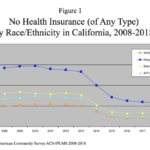
While all population groups were affected by the COVID-19 surge from the summer through the winter of 2020?2021, California’s Latino population was among the hardest hit. Looking at increases in age-specific death rates, we can appreciate how many more Latinos than non-Hispanic whites (NHW) in every age group were killed by COVID-19. …
The surge from the summer through the winter of 2020?2021 affected all racial/ethnic groups, but it hit California’s Latinos particularly hard. In every age group, the disparity between Latino and non-Hispanic white death rates remained roughly the same throughout this period, ranging from two times to seven times as high, depending on age.




